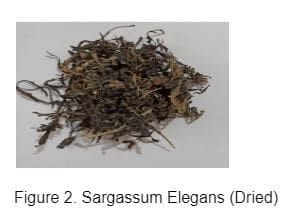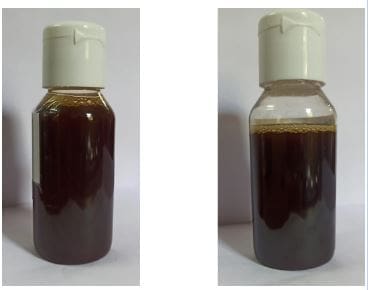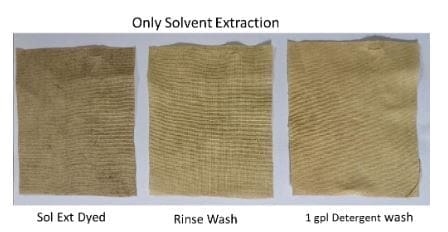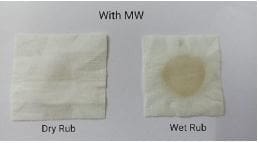Bhushan Chaudhari, Jaydeep Umalkar – Atharvaved Impex, Maharashtra, India.
- SenthilKumar, Sudhir Singh – Triburg ///, Salem, Tamil Nadu, India.
R.Srinivasa Gopalan, Salem, Tamil Nadu, India.
Abstract
Extensive use of synthetic dyes in textiles have led to graver polluting environmental concerns, due to which brands are deliberated to look for sustainable options for saving the planet. This paper discusses the extraction and dyeing with the natural dyes from the brown seaweed Sargassum Elegans. Here for extraction of color pigment a combination of microwave assisted solvent extraction method has been used. Thus the extracted pigment solution was concentrated by simple evaporation technique. This extracted natural pigment has been dyed on cotton yarn as well as fabric using the ultra-rapid dyeing technique with the suitable mordant. The sustainable ultra-rapid dyeing technology is based on zero trade effluent generation and zero emissions. The obtained colors using normal solvent extraction and microwave assisted solvent extraction are compared for their depth of shade, and various fastness properties. Finally the results indicated that the microwave assisted method has excellent depth and fastness properties. Using the ultra-rapid dyeing technology commercial production of this natural dyeing can be done as per requirement.
Keywords: Ultra-rapid dyeing, Natural dyes, brown seaweed Sargassum Elegans, sustainable
Introduction
Nowadays, interest in the use of natural dyes has been growing rapidly due to stringent environmental standards imposed by environmental boards and pollution control boards of many countries in response to environmental and health issues associated with synthetic dyes (Kamel et al., (2005)). Research has shown that synthetic dyes and their related processes release harmful chemical pollutants in both water and land which would be allergic, carcinogenic and detrimental to human health. Natural dyes from plants provide an important alternative to petrochemical based dyes, only if harvesting is carefully managed without affecting environmental and social benefits. Natural dyes not only release medicinal properties but also improve the aesthetic value of the product and they are unique and ecofriendly (Neha Grover et al., (2011)).
About 71% of the worlds surface is covered with water of which 96.5 % of water is in oceans. Sargassum is a seaweed that belongs to the class of phaeophyceae that grows wild in abundance throughout the world, especially along with the coastal areas in Southeast Asia (Ale MT et al., (2012)). Algal forms are the richest source of pigments and can be produced in renewable manner, since they produce some unique pigments sustainably (Patrick Galaupa et al.,(2005)). Optimized process parameter with microwave assisted solvent extraction using Response Surface Methodology (RSM) based on Central Composite Design (CCD) have been used for extraction of pigments from seaweed (P A Handayani et al., (2021)).
Brown pigment in seaweed contains carotenoid (fucoxanthin) which could even provide a new functional food and cosmetic ingredient with anti-metabolic syndrome activity (anti-obesity, anti-diabetes) (S.K. Chandini et al., (2008)) that has important nutraceutical properties, including antioxidants. Besides providing anti-obesity, anti-inflammation effect (H. Maeda et al., (2008)), low risk for breast cancer (X.J. Duan et al., (2006)), prostate cancer cells (E.K. Nara, et al., (2001)) and a diminishing risk of cardio-vascular disease (P. Burtin et al., (2003)) .
This study shows the effective use of extracted pigments for dyeing of cotton using the most sustainable ultra-rapid dyeing technology. The process of production of natural dyes from algae and subsequent dyeing with cotton does not involve the usage of harmful and/or polluting chemicals. The majority of these effluents are biodegradable and can also be reused as fodder, bio plastics etc. Due to Non-Toxicity and Non Carcinogenicity there has been steady increase in the need for non-toxic eco friendly colorants and dyes from Algae for dyeing of textiles. In the present work brown seaweed extracts were used to dye the cotton fabrics at optimized conditions by using a single mordant and color fatness of the dyed fabrics were also evaluated.
Materials and Methods
Materials
Seaweed, ethanol, ferrous sulfate and water. The tools used are scissors, blender, analytical scales, glassware, pH paper, thermometer, microwave, electric heater, filter paper and UV-Vis spectrophotometer.
Preparation of seaweed
Seaweed samples (Figure 1, 2) were collected from the coast of Tamil Nadu and were identified as Sargassum Elegans (Moe, R.L. (1996)). These raw materials were washed with distilled water and sun dried for 48 hours. Then they were dried in an oven at 60 °C for 12 hours.
Kingdom: Plantae (Plants)
Phylum/Division: Phaeophyta (Brown algea)
Class: Phaeophyceae
Order: Fucales
Family: Sargassceae
Genus: Sargassum
Species: Sargassum Elagans

Extraction of dye pigment
Seaweed with certain moisture was cleaned to remove any foreign matters, after cleaning this, weighed 15 gm. carefully. Samples were exposed to the microwave for 1 minute under controlled conditions in 4 cycles. After which they were cooled at room temperature. The Second sample of 15 gms seaweed was taken as it is. Both samples were taken separately and treated as follows. Samples were powdered using a blender and sieved. Here for extraction of pigment soxhlet extraction apparatus has been used. The powdered sample was carefully loaded in the thimble of the soxhlet extractor. The solvent for extraction taken was 50 ml ethanol and 100 ml distilled water. The solvent was heated to the boiling temperature and the extraction was carried out for 3 hours, this cycle was repeated for 2 times. After extraction the extract was vacuum filtered. The extracted pigment in the solvent was further concentrated using a rotary evaporator to reduce the volume to 100 ml. This pigment solution was water with pigment in it and all the ethanol was removed.

Figure – 3. Figure – 4
Figure 3 shows the extract from microwave assisted solvent extraction and figure 4 shows extract from regular solvent extraction.
Ultra-rapid natural dyeing
Both the extracts were taken for dyeing separately. RFD Cotton fabric sample with less than 3 sec absorbency was taken for dyeing. For dyeing, the previously extracted solution was taken in the padding trough. To achieve fastness properties simultaneous mordanting and dyeing was carried out, here the mordant forms a coordination complex with the dye and aids the attachment of dye onto the fabric. There are various mordants available such as alum, tannic acid, stannous chloride, copper sulfate, ferrous sulfate etc. In this case the mordant used was ferrous sulfate to get dark shade and better fastness properties. 20 gpl of ferrous sulfate was used in dyeing. Dyeing was carried out in the ultra-rapid dyeing machine where the fabric was dipped through a physio-acoustic applicator containing dye and mordant solution at room temperature and squeezed through the padding mangle followed by drying at 90 degree c and curing at 150 degree c. pH of the dyeing solution throughout the process was 7. Thus both the dyed fabric were rinse washed for further testing and analysis.
Color Measurement and Color Coordinates
The natural dyed fabrics were measured and examined for color strength (K/S) and color reflectance by spectrophotometer. The K/S value is the value used to measure the strength of absorbency. The depth of color of the dyed fabric was determined by analyzing the K/S value of a given dyed sample. The dyed sample were analyzed and expressed in terms of their L* a* b* values. The L* values designate perceived lightness or darkness. Value of 0 indicates black and 100 defines white. The values of a* indicate redness (+a) or greenness (-a), while value of b* shows yellowness (+b) or blueness (-b).
Color Fastness Properties
Color fastness is the resistance of a material to change any of its color characteristics or extent of transfer of its colorants to adjacent white materials in touch. The color fastness is usually rated either by loss of depth of color in the original sample or it is also expressed by staining scale. However, among all types of color fastness, light fastness, wash fastness and rub fastness are considered general for any textiles. Meanwhile, perspiration fastness is considered specific for certain apparels (Samanta, A. K. et al.,(2009)). In this trial, color fastness of dyed fabric was analyzed in terms of washing fastness and rubbing/crocking fastness. All methods were carried out in accordance with Standard adopted from ISO Standard. All samples were graded from scale 1(the worst) to 5 (the best) as indicated by AATCC. The summary of the tests is given in figure 12. These scale were used to assess color change and to measure the staining amount referral to undyed fabrics during fastness tests.
Color Fastness to Washing
Color fastness to washing was determined using standard ISO 105-A05-200 3 test method. A sandwiched sample of size 10 cm x 4 cm was prepared for every dyed fabric. Then, a soap solution with liquor ratio 1:50 was prepared according to the respective weight of the sandwiched sample. All sandwiched samples were soaked in the soap solution in a vessel and rotated for 30 minutes at 60°C.. After completion of process the samples were air dried followed by evaluation on the color changes using the standard grey scale under the lighting cabinet as noted in figure 12.

Figure – 5

Figure – 6

Figure – 7

Figure – 8
Color Fastness to Rubbing
Color fastness to rubbing was determined using ISO 105-X12-2001. This test method was developed to measure the amount of color transferred from the surface of colored textile material onto other surfaces by rubbing A specimen of sized of 20 cm x 11 cm was set and placed on the crock meter a rubbing finger which was covered with 5 cm x 5 cm cotton cloth was rubbed to the specimen for ten turns at the rate of one turn per second for both dry and wet tests. Finally color which were stained on the white cotton cloths were evaluated under the lighting cabinet using the standard grey scales as given in figure 12.

Figure – 9

Figure – 10
RESULTS AND DISCUSSION
The result of the experiment shows that natural dyes extracted using the microwave assisted soxhlet extraction is effective and efficient in getting an higher yield, in shorter time using less energy consumption and less needed solvents, this extraction method suits very well for solid liquid extraction in plants (Rastrelli L et al. (2018)), (Ingrath W et al., (2015)). This sizable concentration of brown pigment extracted from seaweed (Figure 3,4) which have been easily dyed on cotton fabric in a continuous form using the ultra-rapid dyeing method. By using the ferrous mordant dark shades are possible with overall good fastness properties. The carotenoid (fucoxanthin) in the dye pigments gives the dark brown and golden brown color (Wiraningtyas et al., (2018))and also a permanent brown shade to the cotton fabric with better wash fastness as shown in figure 5,6,7,8.
The function of K/S is directly proportional to the concentration of colorant in the substrate. High K/S values (Figure 13) shows a higher amount of dyestuff in the fabric resulting in deeper shade as seen in the case of microwave assisted solvent extracted sample. Similar graph trends indicate that the dyes are from the same source. From the color measurement readings as given in figure 11 we can find that the depth of shade is darker in the microwave assisted solvent extraction dyed sample. Also in further washes the shade retains more in microwave assisted solvent extraction dyed sample. Rubbing fastness of the dyed material is also at par with the industry standards as in figure 9,10. To summarize the findings figure 12 shows the gray scale readings of the samples.
Due to the unique process of ultra-rapid dyeing where the fabric is pad nip dried and cured resulting in no effluent generation throughout the process. Seaweed natural Dyeing is done using natural materials only in neutral pH hence no after wash is done. Thus making the product and the process completely sustainable.
| Color Measurement Values | |||||
| Extraction Method | Sample | L* | a* | b* | Ap. Strength |
| Solvent Ext. | Dyed | 62.64 | 6.16 | 24.21 | — |
| Rinse wash | 71.41 | 4.77 | 20.17 | 47.41% | |
| Detergent wash | 72.25 | 5.29 | 22.17 | 47.49% | |
| Wash fast. Color | 72.25 | 6.16 | 23.87 | 49.56% | |
| Microwave assisted Solvent Ext. | Dyed | 56.2 | 6.28 | 22.43 | — |
| Rinse wash | 62.25 | 5.9 | 21.97 | 65.07% | |
| Detergent wash | 64.71 | 5.93 | 23.07 | 56.99% | |
| Wash fast. Color | 63.03 | 7.94 | 26.26 | 69.30% | |
Figure – 11
| Fastness comparison | |||||
| Method | Mordants | Washing | Rubbing/Crocking | ||
| Color | Dry | Wet | |||
| Change | Cotton | ||||
| Regular Solvent Extraction | Ferrous Sulphate | 3-4′ | 4′ | 5′ | 4′ |
| Microwave assisted Solvent Extraction | Ferrous Sulphate | 3-4′ | 4′ | 5′ | 3′ |
Figure – 12

Figure – 13
CONCLUSION
In conclusion, pigment extracted from Sargassum Elegans. Seaweed can be utilized as a natural dye producing unique and interesting shades on cotton textiles. The shades vary depending on the concentration of extracts and mordant used which gives desired shade depth and acceptable fastness properties. The microwave assisted solvent extraction proved to be effective and efficient in extracting the pigment from the seaweed. This extraction procedure poses no difficulty in commercial production of pigment extraction due to simplicity of the process. Water is an essential chemical for the dyeing and finishing industry. However, the prevention at source can be achieved by the use of new technologies. Ultra-rapid dyeing technology is one of the new technologies where pad dry and cure process is followed using appropriate chemicals for maximizing dye pickup through an physio-acoustic applicator. Here continuous application of natural dyes is possible using the said process and has a good prospect in the manufacturing for sustainable textiles.
Reference
- Kamel M M, El-Shishtawy R M, Yussef B M and Mashaly H (2005), Ultrasonic assisted dyeing: III. Dyeing of wool with lac as a natural dye, Dyes Pigments, 65, 103-110.
- Neha Grover and Vidya Patni (2011), Extraction and application of natural dye preparations from the floral parts of Woodfordia fruticosa (Linn.) Kurz, Indian Journal of Natural Products and Resources Vol. 2(4), pp 403-408.
- Ale MT, Mikkelsen JD, and Meyer AS 2012 Designed optimization of a single-step extraction of fucose-containing sulfated polysaccharides from Sargassum sp. J. Appl. Phycol. 24 715– 723
- Silva, P.C., Basson, P.W. & Moe, R.L. (1996). Catalogue of the benthic marine algae of the Indian Ocean. University of California Publications in Botany 79: 1-1259.
- Laurent Dufosse,Patrick Galaupa, Anina Yaronb,Shoshana Malis Aradb, Philippe Blancc, Kotamballi N. Chidambara Murthyd and Gokare A. Ravishankar, Microorganisms and microalgae as sources of pigments or food use: a scientific oddity or an industrial reality?, Trends in Food Science & Technology,2005,16:389-406
- Optimization of microwave-assisted extraction of dyes from brown seaweed (Sargassum duplicatum) using response surface methodology : P A Handayani et al 2021 IOP Conf. Ser.: Earth Environ. Sci. 700 012039
- Samanta, A. K., & Agarwal, P. “Application of natural dyes on textiles,” Indian Journal of Fibre & Textile Research, vol. 34, 2009, pp. 384–399
- Ruslan and Wiraningtyas A 2018 Extraction of Pigment Color from Sargassum sp. seaweeds J. Redoks ( J. Pendidik. Kim. Dan Ilmu Kim.) 2 1–10
- Belwal T, Ezzat SM, Rastrelli L et al. 2018 A critical analysis of extraction techniques used for botanicals: Trends, priorities, industrial uses and optimization strategies TrAC – Trends Anal. Chem.100 82–102
- Ingrath W, Nugroho WA, and Yulianingsih R 2015 Ekstraksi Pigmen Antosianin dari Kulit Buah Naga Merah (Hylocereus Costaricensis) Sebagai Pewarna Alami Makanan dengan Menggunakan Microwave (Kajian Waktu Pemanasan dengan Micrawave dan Penambahan Rasio Pelarut Aquades dan Asam Sitrat) J. Bioproses Komod. Trop. 3 1–8
- S.K. Chandini, P. Ganesan, P.V. Suresh, N. Bhaskar, J. Food Sci. Technol. 45 (2008) 1.
- H. Maeda, T. Tsukui, T. Sashima, M. Hosokawa, K. Miyashita, Asia Pac. J. Clin. Nutr. 17 (2008) 196
- X.J. Duan, W.W. Zhang, X.M. Li, B.G. Wang, Food Chem. 95 (2006) 37
- E.K. Nara, M. Kushiro, H. Zhang, T. Sugawara, K. Miyashita, A. Nagao, J. Nutr. 131 (2001) 3303.
- P. Burtin, EJEAFChe: Agric. Food Chem. 2 (2003) 498.

